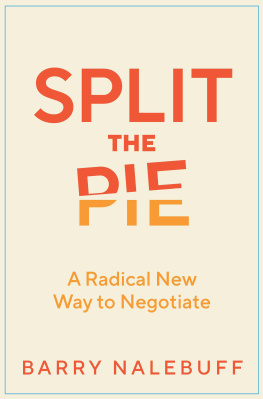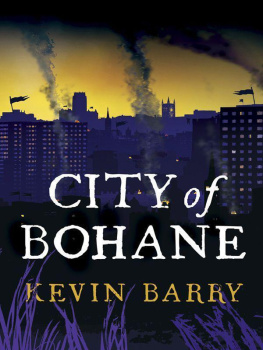Barry Nalebuff - Split the Pie
Here you can read online Barry Nalebuff - Split the Pie full text of the book (entire story) in english for free. Download pdf and epub, get meaning, cover and reviews about this ebook. year: 2022, publisher: HarperCollins, genre: Romance novel. Description of the work, (preface) as well as reviews are available. Best literature library LitArk.com created for fans of good reading and offers a wide selection of genres:
Romance novel
Science fiction
Adventure
Detective
Science
History
Home and family
Prose
Art
Politics
Computer
Non-fiction
Religion
Business
Children
Humor
Choose a favorite category and find really read worthwhile books. Enjoy immersion in the world of imagination, feel the emotions of the characters or learn something new for yourself, make an fascinating discovery.
- Book:Split the Pie
- Author:
- Publisher:HarperCollins
- Genre:
- Year:2022
- Rating:5 / 5
- Favourites:Add to favourites
- Your mark:
- 100
- 1
- 2
- 3
- 4
- 5
Split the Pie: summary, description and annotation
We offer to read an annotation, description, summary or preface (depends on what the author of the book "Split the Pie" wrote himself). If you haven't found the necessary information about the book — write in the comments, we will try to find it.
Split the Pie — read online for free the complete book (whole text) full work
Below is the text of the book, divided by pages. System saving the place of the last page read, allows you to conveniently read the book "Split the Pie" online for free, without having to search again every time where you left off. Put a bookmark, and you can go to the page where you finished reading at any time.
Font size:
Interval:
Bookmark:
To Herb Cohen and David Stern (19422020),
two negotiation giants from whom Ive had the privilege to learn.
Negotiation is stressful. Thats even true for me. A great deal is at stake: money (sometimes life-changing money), opportunity, time, relationships, and reputations. Negotiation can bring out the worst in people as they try to take advantage of the other side or just navely imitate the tough negotiatiors they hear about.
Wouldnt it be better if there were a principled way to negotiate? Wouldnt it be even better if there were a way to treat people fairly and get treated fairly in a negotiation? Split the Pie does both via a radical new approach to negotiation, one I have been teaching to MBA students and executives at Yale School of Management for the last fifteen years and to over 350,000 online learners at Coursera. Its the approach I used in selling my company to Coca-Cola. Its a simple, practical approach based on ideas from game theory. Like all good new ideas, it is also old. The fundamental insight can be traced back to the two-thousand-year-old Babylonian Talmud. (We explore this connection in .)
I start by helping you identify whats really at stake in a negotiationwhat I call the pie. The pie is the additional value created through an agreement to work together. Once you see the pie, you will change how you think about fairness and power in negotiation. The notion of dividing the pie is commonplace in negotiations. But most people are splitting the wrong pie; they focus on the total amount, not the gain created by an agreement. As a result, they argue over the wrong numbers and issues, and take positions they perceive as reasonable but are, in fact, self-interested. The hard part of negotiation is to measure the pie correctly. When the stakes are correctly understood, it is far easier to reach an agreement.
In a nutshell, negotiation is about creating and capturing value. When it comes to creating value, Roger Fisher and William Urys Getting to Yes taught the world how to succeed by focusing on interests, not positions. Left unresolved is the messy problem of how to divide the gains created, whether they be synergies in a merger or cost savings from sharing an Uber. The resulting tension is why many people so dislike negotiating.
To resolve the tension, some negotiators appeal to fairness: Ive given you a fair offer. You should take it. But what looks fair to one side may not look so fair to the other. One side could offer less than half and still call this fair if the other side cares more about the deal. In other circumstances, one side might argue its fair to split everything down the middle, even if the starting points are different. I think such divisions dont reflect the true nature of fairness in a negotiation.
Other negotiators appeal to arguments based on power. One side will argue it is entitled to a larger share because it is bigger, because it brings more to the table, because it can walk away more easily, because it has more options, and so on. Such appeals to power often prevail. The typical result is to divide things up proportionately, where the proportionality may be in terms of size (units, revenue, profit, dollars invested), or some other supposed metric of power. I think such divisions are flawed and dont reflect the true nature of power in a negotiation.
This book introduces a new approach, one that reveals the true power of the players and is fair in representing their contributions. The radical part is the conclusion that the pie should be divided evenly. That doesnt mean both sides end up with the same amount. What is evenly divided is not the total but only the additional value created by the agreement, namely the negotiation pie. Because this even split fundamentally changes how people look at power, there will be resistanceespecially from people who benefit from the illusion of power under the status quo. However, that resistance can be overcome, and Ill explain how.
What you will get from Split the Pie is a practical and theory-based approach to negotiation. When I say the approach is practical, I mean it has been field-tested. Youll read how it helped reframe what was for me a high-stakes negotiation when Coca-Cola purchased Honest Tea, a company I cofounded with my former student Seth Goldman. (We are the Seth & Barry on the back label.) That negotiation in 2008 was when the theory first moved beyond the classroom. Until then, it had been an idea germinating in my Yale negotiation course. The pie approach was developed out of necessity to help overcome Cokes reasonable objection that they didnt want to pay for value they helped create. Early on, we agreed to split the pie, whatever it turned out to be, and that gave both sides an incentive to make the pie as big as possible, which is just what we did.
The pie framework isnt just for high-stakes corporate negotiations. Youll learn how the pie will help guide negotiations should you ever need to break a lease with a landlord or buy a domain name from a squatter. Youll learn a better way to split costs between partners when the benefits are unequal. Youll learn how smart real estate lawyers in New York City employ the pie to rebalance an unfavorable default split of tax savings and thereby gain several thousand dollars for their clientsand youll learn how to do it, too.
The pie framework will change the way you approach negotiations in business and in your personal life. It will allow you to see the negotiation more clearly and more logically. It will lead you to an agreement where the principle applied doesnt depend on the specifics of your situation. It will help you make arguments that persuade others by identifying inconsistencies in their approach.
Splitting the pie works when there is an opportunity to cooperate with the other side to maximize the value you can create together. As youll soon see, it also works when going up against someone who doesnt care about fairness or the pie perspective. Because it is principled and because it leads to fair results, this approach offers the potential for negotiation without all the posturing. Achieving a fair division allows both sides to focus their energy on making the biggest possible pie. The pie framework goes a long way toward resolving the tension between creating and capturing value.
It will soon be apparent that this book has more numbers than your typical negotiation guide. The numbers serve a purpose. They help build your understanding of the pie logic across different applications. The details allow you to fully engage with the examples. You are given enough information so that you can push back rather than take the answers on faith. I hope you will get some of the exciting experience of being in an MBA case discussion. At the same time, I do my best to keep the numbers simple: no Excel is required.
You may wonder if this is asking you to be too logical and too analytical. What about emotions and empathy? Of course, emotions matter. Yes, empathy is critical. Indeed, it is fully rational to be empathetic. But logic in negotiation is fundamental and is far less understood. Having a logical argumenta principle to refer tocan help bring down the emotions. The pie logic is what allows you to find truly fair solutions. The logic is what allows you to make a principled stand.
Dont worry, this book is not The Vulcan Guide to Negotiation. While the first half of the book focuses on the logic, the second half focuses on empathy. The tools and cases there are designed to help you be less egocentric and more allocentricmore centered on others. Empathy, not sympathy or charity, will help you better understand the other partys objectives and thereby expand the pie. Logic will ensure you get your fair share. If you can combine logic and empathy, youll have the best of Mr. Spock and Captain Kirk.
Font size:
Interval:
Bookmark:
Similar books «Split the Pie»
Look at similar books to Split the Pie. We have selected literature similar in name and meaning in the hope of providing readers with more options to find new, interesting, not yet read works.
Discussion, reviews of the book Split the Pie and just readers' own opinions. Leave your comments, write what you think about the work, its meaning or the main characters. Specify what exactly you liked and what you didn't like, and why you think so.





